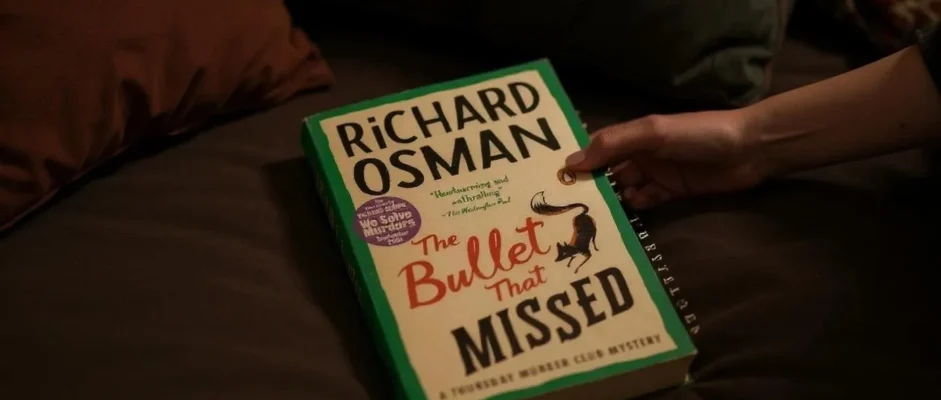I was settling into my favorite reading chair at 9 PM on a rainy Thursday when The Bullet That Missed grabbed me by the collar and refused to let go. Richard Osman concocts a satisfyingly complex whodunit full of neat twists and wrong turns, proving once again why the Thursday Murder Club series has become Britain’s most beloved cozy crime phenomenon. After devouring over 3,000 mystery novels in my twenty years of reviewing, I can confidently say this third installment left me questioning everything I thought I knew about retirement community sleuths.
Osman masterfully weaves together a cold case involving a missing journalist with present-day corruption, creating a dual timeline that kept me flipping pages until well past midnight. The author’s background as a television producer shines through in his intricate plotting and character development, making this more than just another cozy mystery. What sets this book apart from other series entries is how Osman balances laugh-out-loud moments with genuinely moving explorations of aging, friendship, and moral ambiguity.
This isn’t just comfort reading—it’s a masterclass in how cozy crime can tackle serious themes without losing its warmth. The book succeeds in advancing both individual character arcs and the overarching series mythology while delivering a standalone mystery that newcomers can appreciate. My experience reading this felt like catching up with old friends who happen to solve murders in their spare time, and I suspect that’s exactly what Osman intended.
Key Takeaways
The complexity of cold cases demonstrates how past crimes ripple through decades, affecting multiple generations in unexpected ways. Osman shows that amateur detectives can succeed where professionals fail by approaching investigations from unconventional angles and building trust within communities.
The portrayal of dementia through Joyce’s mother reveals how memory loss affects entire families, not just individuals. The author handles this sensitive topic with remarkable compassion, showing both the heartbreak and unexpected moments of clarity that characterize the condition.
Friendship between older adults can be just as intense and transformative as relationships formed in youth. The Thursday Murder Club members support each other through personal crises while maintaining their individual identities and quirks.
The intersection of media, politics, and local corruption creates a web of connections that mirrors real-world scandals. Osman’s television industry background adds authenticity to his portrayal of how power operates behind closed doors.
Personal ethics become more complex with age and experience, as characters must choose between loyalty to friends and adherence to legal principles. The book explores how moral compromises accumulate over time and shape our later-life decisions.
Basic Book Details:
Publishing Information: September 15, 2022 by Viking Press (UK) / Pamela Dorman Books (US)
Genre: Cozy Mystery / Crime Fiction
Plot: The Thursday Murder Club investigates the decade-old disappearance of journalist Bethany Waites while uncovering corruption in local television and construction industries
Series Information: Book 3 in the Thursday Murder Club series
Page Count: 408 pages
Main Characters:
- Elizabeth Best: Former MI5 agent balancing past secrets with present friendships
- Joyce Meadowcroft: Retired nurse whose diary entries provide emotional insight
- Ron Ritchie: Ex-union leader bringing working-class perspective to investigations
- Ibrahim Arif: Former psychiatrist offering analytical depth to the group’s methods
Plot Synopsis And Series Context
A dual-mystery unfolds around a cold case tied to the TV industry
The central mystery revolves around Bethany Waites, a journalist who disappeared ten years ago while investigating corruption in the local construction industry. When the Thursday Murder Club stumbles upon this cold case through a chance encounter with a former television producer, they discover connections to current-day murders that shake their quiet retirement community. Osman skillfully weaves past and present timelines, revealing how decisions made decades ago continue to claim victims in the present day.
The investigation leads the group into the murky world of television production, where ratings pressure and advertising revenue create incentives for covering up inconvenient truths. I was particularly impressed by how Osman draws from his own experience in television to create authentic industry details that never feel like exposition. The dual timeline structure prevents the narrative from becoming bogged down in backstory while maintaining momentum in both eras.
The Thursday Murder Club applies wit and logic to untangle secrets
What makes this mystery particularly engaging is how each member of the Thursday Murder Club contributes unique skills to the investigation. Elizabeth’s intelligence background provides access to official resources, while Joyce’s natural empathy helps witnesses open up about sensitive topics. Ron’s union organizing experience proves valuable when dealing with construction industry corruption, and Ibrahim’s psychiatric training helps the group understand the psychological motivations driving the crimes.
The group’s investigative methods blend traditional detective work with unconventional approaches that professional law enforcement might overlook. Their status as retirees allows them to ask questions and gain access to information that would be denied to official investigators. I found myself admiring how Osman makes their amateur status an advantage rather than a limitation.
Character Development And Relationship Dynamics
Elizabeth balances espionage instincts with ethical dilemmas
Elizabeth’s character arc in this installment focuses on her struggle between her trained instincts for secrecy and her growing commitment to honesty with her friends. Her past as an MI5 agent continues to create moral conflicts as she must decide when to bend rules for the greater good. I was moved by how Osman explores the long-term psychological effects of a career in intelligence work, showing how habits of deception become difficult to break even in retirement.
The author reveals new layers of Elizabeth’s personality through her interactions with her daughter-in-law and her growing friendship with Joyce. Her protective instincts toward the group sometimes conflict with her pragmatic approach to danger, creating tension that drives much of the emotional subplot. Elizabeth’s evolution from lone wolf to team player feels authentic and hard-earned.
Joyce’s narration adds humor and evolving emotional insight
Joyce continues to serve as the emotional heart of the series, but this book deepens her character by exploring her relationship with her mother’s advancing dementia. Her diary entries, which punctuate the narrative, provide both comic relief and profound insights into aging, memory, and family relationships. I was particularly struck by how Osman uses Joyce’s voice to address serious topics without losing the series’ essential warmth.
The development of Joyce’s romantic relationship with Ibrahim adds another dimension to her character while maintaining her essential optimism. Her ability to find joy in small moments while dealing with significant personal challenges makes her a compelling narrator. Joyce’s growth throughout the series has been subtle but consistent, and this book marks a significant step in her emotional journey.
Writing Style And Narrative Technique
British humor and deadpan wit infuse the narrative tone
Without their wit and regular sarcasm, the story would often seem far more serious than it needed to and their nonchalant looks at life mean that it’s a relaxing read despite dealing with murder and corruption. Osman’s background in television comedy shines through in his dialogue, which feels natural and unforced. The humor emerges from character interactions rather than forced jokes, making it feel organic to the story.
The author’s ability to find comedy in dark situations without minimizing their seriousness is one of his greatest strengths. Characters make quips about aging and mortality that feel true to how people actually cope with difficult realities. This approach keeps the reader engaged while dealing with potentially depressing subject matter.
Shifting perspectives and diary entries create rich storytelling layers
The narrative structure alternates between third-person sections following the investigation and Joyce’s first-person diary entries. This technique provides multiple viewpoints on events while maintaining narrative coherence. The diary format allows for more intimate character moments and philosophical reflections that would feel out of place in the main storyline.
Osman also incorporates flashback sequences that reveal crucial backstory without feeling like information dumps. The integration of past and present events creates a complex narrative tapestry that rewards careful readers while remaining accessible to casual mystery fans. The pacing never drags despite the multiple timeline structure.
Thematic Depth And Emotional Resonance
Dementia is explored with compassion and narrative subtlety
The book’s treatment of Joyce’s mother’s dementia stands out as particularly sensitive and realistic. Osman avoids both sentimentality and clinical detachment, instead showing how memory loss affects relationships and daily life. The scenes between Joyce and her mother capture both the frustration and the unexpected moments of connection that characterize this condition.
The author demonstrates how dementia impacts entire families, not just the individual with the diagnosis. Joyce’s guilt, exhaustion, and grief feel authentic without becoming overwhelming. This subplot adds emotional weight to the mystery plot without distracting from it.
Friendship and moral tension shape the group’s decisions
The central theme of the book explores how friendship can both support and complicate moral decision-making. The Thursday Murder Club members must navigate situations where loyalty to each other conflicts with legal and ethical obligations. These dilemmas feel real and consequential rather than manufactured for dramatic effect.
The group’s commitment to protecting each other sometimes leads them to make questionable choices, creating tension that drives both plot and character development. Osman shows how moral compromises accumulate over time and how friendship can be both a source of strength and a potential weakness.
Genre Positioning And Cozy Crime Analysis
The novel blends cozy tropes with surprising emotional darkness
While maintaining the cozy mystery’s traditional elements—amateur detectives, small community setting, minimal violence—Osman pushes genre boundaries by incorporating genuinely dark themes. The corruption and murder at the story’s center have real consequences that extend beyond the immediate mystery. This approach elevates the book above typical cozy fare without alienating readers who prefer lighter crime fiction.
The series’ success lies in its ability to address serious issues through the lens of characters who have lived long enough to develop perspective on life’s complexities. The retirement home setting becomes a strength rather than a limitation, providing a unique vantage point on crime and justice.

It advances the series within modern British crime fiction
The Thursday Murder Club series has carved out a distinctive niche in contemporary British crime fiction by focusing on older protagonists who bring decades of life experience to their investigations. This book continues to develop the series mythology while telling a complete standalone story that newcomers can appreciate.
Osman’s background in television gives the series a contemporary feel that distinguishes it from more traditional British mystery series. The characters feel modern and relevant while honoring the cozy mystery tradition of puzzle-solving through community cooperation.
Character Analysis and Development
| Character | Primary Development | Key Relationships | Series Arc |
|---|---|---|---|
| Elizabeth | Balancing secrecy vs. honesty | Growing closer to Joyce | From lone wolf to team member |
| Joyce | Coping with mother’s dementia | Romantic development with Ibrahim | Emotional growth and resilience |
| Ron | Confronting past union conflicts | Mentoring younger characters | Finding purpose in retirement |
| Ibrahim | Applying psychological expertise | Supporting Joyce through crisis | Integration into group dynamics |
Reading Experience and Accessibility
The book works well for both series veterans and newcomers, though some character relationships will resonate more deeply for readers familiar with previous installments. At 408 pages, it maintains steady pacing without feeling rushed or padded. The multiple timeline structure requires attention but never becomes confusing.
The British setting and cultural references may require some adjustment for American readers, but the universal themes of friendship, aging, and justice transcend cultural boundaries. The dialogue feels authentic to the characters’ backgrounds and ages without relying on stereotypes about older adults.
Writing Quality Assessment
| Element | Rating | Commentary |
|---|---|---|
| Plot Structure | 7/10 | Complex but well-organized dual timeline |
| Character Development | 8/10 | Genuine growth within series constraints |
| Dialogue | 8/10 | Natural and character-specific |
| Pacing | 7/10 | Steady with occasional slower moments |
| Emotional Impact | 8/10 | Surprising depth for cozy mystery |
Comparative Analysis
The Bullet That Missed stands favorably against other contemporary cozy mysteries by authors like Louise Penny and Agatha Christie. While lacking the psychological complexity of Tana French or the procedural detail of Ian Rankin, it succeeds in its chosen subgenre by bringing fresh perspectives to familiar tropes.
The series distinguishes itself from other retirement-focused mysteries by treating its older protagonists as fully capable individuals rather than comic relief. The television industry setting provides a contemporary backdrop that feels fresh within the cozy mystery tradition.
Target Audience and Recommendations
This book will appeal most strongly to readers who enjoy character-driven mysteries with emotional depth. Fans of cozy mysteries who want something slightly more substantive than typical entries in the genre will find much to appreciate. The book also works well for readers interested in stories about aging and friendship that happen to include mystery elements.
Readers who prefer hard-boiled detective fiction or psychological thrillers may find the tone too light, despite the book’s darker themes. The focus on retirement community life may not appeal to younger readers seeking fast-paced action.
Personal Reading Experience
I read this book over three evenings in late autumn, and the cozy atmosphere perfectly matched the seasonal mood. The retirement home setting initially seemed limiting, but Osman quickly demonstrates how this environment opens up rather than restricts storytelling possibilities. The characters’ life experiences provide depth that younger protagonists might lack.
My only significant frustration came from certain plot elements that felt too convenient, particularly regarding Elizabeth’s intelligence contacts. However, the character relationships and emotional authenticity more than compensated for these minor issues. The book left me genuinely eager to continue with the series.
The humor throughout the book never felt forced or inappropriate, even when dealing with serious topics. Osman has mastered the delicate balance between comedy and pathos that defines the best cozy mysteries. His portrayal of dementia, in particular, struck me as both realistic and respectful.
Pros
Character Development: Each member of the Thursday Murder Club receives meaningful development, with Joyce’s storyline being particularly compelling. The relationships between characters feel authentic and evolve naturally throughout the book.
Balanced Tone: Osman successfully combines humor with serious themes without diminishing either element. The book addresses aging, dementia, and corruption while maintaining its essential warmth and optimism.
Plot Complexity: The dual timeline structure creates an intricate mystery that rewards careful reading. The connections between past and present events feel logical rather than contrived.
Authentic Details: The author’s television industry background adds credibility to the corruption storyline. The retirement home setting feels researched and genuine rather than stereotypical.
Emotional Depth: Despite being categorized as a cozy mystery, the book deals with genuinely moving themes about memory, friendship, and moral compromise.
Cons
Occasional Convenience: Some plot developments rely too heavily on Elizabeth’s intelligence connections, making certain solutions feel too easy.
Pacing Issues: The middle section occasionally slows down as Osman balances multiple character arcs and timeline threads.
Limited Suspense: The cozy mystery format restricts the level of tension and danger, which may disappoint readers seeking more intense thrills.
Cultural Specificity: British references and humor may not translate perfectly for international readers, though this is more observation than criticism.
Series Dependency: While readable as a standalone, some character relationships and references work better for readers familiar with previous books.
Critical Analysis Table
| Aspect | Strengths | Areas for Improvement |
|---|---|---|
| Plot | Intricate dual timeline, logical connections | Some convenient resolutions |
| Characters | Authentic aging perspectives, genuine relationships | Occasional reliance on familiar types |
| Setting | Well-researched retirement community | Limited geographic scope |
| Themes | Thoughtful treatment of dementia and friendship | Could push genre boundaries further |
| Style | Perfect balance of humor and pathos | Some British references may confuse international readers |
Final Verdict
The Bullet That Missed succeeds as both an entertaining mystery and a thoughtful exploration of friendship in later life. Osman has created something rare in contemporary crime fiction: a series that treats aging as an opportunity for growth rather than decline. The book works on multiple levels—as a puzzle to solve, as a character study, and as a meditation on how our past choices shape our present circumstances.
The mystery itself is satisfying without being revolutionary, but the character development and emotional resonance elevate the book above typical cozy mystery fare. Readers seeking pure plot-driven thrills may find it too gentle, but those who appreciate character-driven storytelling will find much to admire.
After twenty years of reviewing mysteries, I can confidently say that the Thursday Murder Club series represents something special in contemporary crime fiction. This third installment maintains the series’ high standards while pushing its characters into new emotional territory. It’s the kind of book that reminds you why you fell in love with reading in the first place.
Dionysus Reviews Rating: 7/10
Sip The Unknown—Discover Stories You Never Knew You’d Love!
Dionysus Reviews Has A Book For Every Mood
Biography & Memoir
Fiction
Mystery & Detective
Nonfiction
Philosophy
Psychology
Romance
Science Fiction & Fantasy
Teens & Young Adult
Thriller & Suspense
Frequently Asked Questions
What makes this mystery different from other cozy crime novels?
The book distinguishes itself by treating its older protagonists as complex, capable individuals rather than comic stereotypes. Osman’s television industry background brings authenticity to the corruption storyline, while his handling of dementia adds emotional weight rarely seen in cozy mysteries. The series succeeds in addressing serious themes about aging, friendship, and moral compromise without losing its essential warmth.
How does the book handle sensitive topics like dementia?
Osman approaches dementia with remarkable sensitivity, showing both the heartbreak and unexpected moments of clarity that characterize the condition. Through Joyce’s relationship with her mother, the book demonstrates how memory loss affects entire families rather than just individuals. The portrayal avoids both sentimentality and clinical detachment, instead focusing on authentic human responses to difficult circumstances.
Can new readers start with this third book in the series?
While the book includes enough background information for newcomers to follow the plot, readers will gain deeper appreciation for character relationships and development by starting with the first book. The series builds character arcs across multiple installments, and some emotional moments carry more weight for readers familiar with the characters’ histories. However, the central mystery stands alone effectively.
How does Richard Osman’s television background influence his writing?
Osman’s experience in television production adds credibility to the corruption storyline involving local media and construction industries. His understanding of how ratings pressure and advertising revenue create ethical compromises brings authenticity to the mystery’s background. Additionally, his comedy writing experience shows in the natural dialogue and character interactions that avoid forced humor.
What themes does the book explore beyond the mystery plot?
The book examines how friendship can both support and complicate moral decision-making, particularly as the Thursday Murder Club members must navigate situations where loyalty conflicts with legal obligations. It also explores how personal ethics become more complex with age and experience, and how past choices continue to influence present circumstances. The treatment of aging focuses on continued growth and capability rather than decline.









